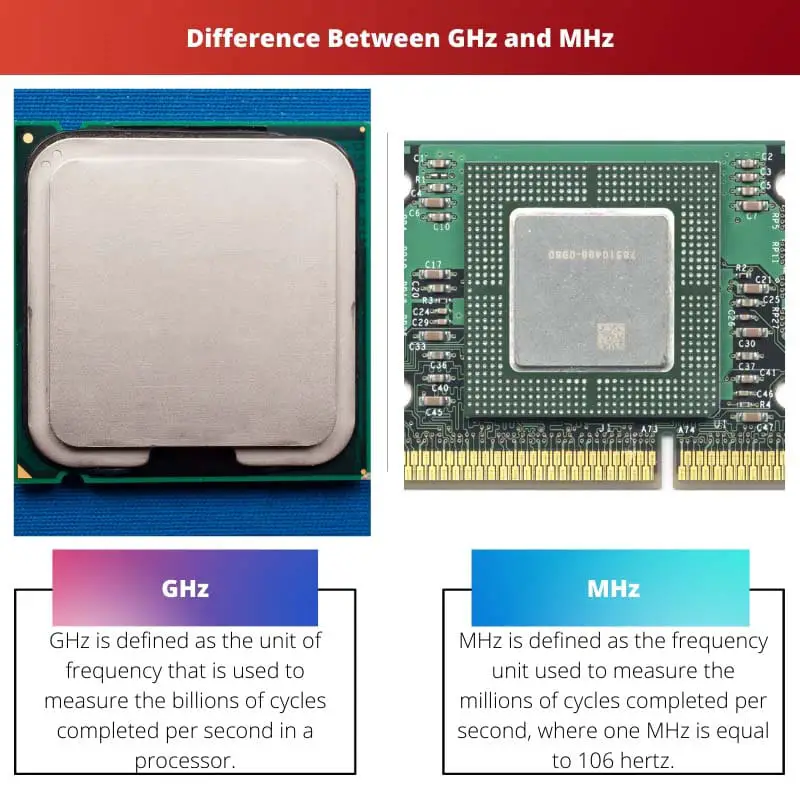GHz (Gigahertz) and MHz (Megahertz) are units used to measure frequencies in electronics. Gigahertz represents billions of cycles per second, while Megahertz represents millions of cycles per second. GHz is used to denote higher frequencies, commonly found in modern computer processors and communication technologies, offering faster processing speeds. Conversely, MHz is used for lower frequencies, seen in older devices or peripherals like memory modules or slower processors.
Key Takeaways
- GHz (Gigahertz) and MHz (Megahertz) are units of measurement for frequency, specifically for measuring the clock speed of a computer processor.
- GHz is equivalent to one billion cycles per second, while MHz is equivalent to one million cycles per second.
- GHz is faster than MHz and indicates a higher processing speed, which is important for running complex applications and multitasking.
GHz vs. MHz
GHz (gigahertz) stands for billions of cycles per second, whose frequencies are used in modern computer processors, indicating the frequency of a signal. MHz (megahertz) stands for millions of cycles per second, with frequencies used more in radio communication and older computer processors.

Comparison Table
| Feature | GHz (Gigahertz) | MHz (Megahertz) |
|---|---|---|
| Unit | One billion cycles per second (10^9 Hz) | One million cycles per second (10^6 Hz) |
| Conversion | 1 GHz = 1000 MHz | 1 MHz = 0.001 GHz |
| Typical Applications | * Modern computer processors (CPUs) and graphics cards (GPUs) * High-speed wireless networks (Wi-Fi 5GHz, 5G mobile networks) * Radar systems * Satellite communications | * Older computer processors * Radio broadcasting (FM radio) * Bluetooth technology * Microwave ovens |
| Relative Speed | Higher frequency, indicating faster signal or data transfer | Lower frequency, indicating slower signal or data transfer |
What is GHz?
Gigahertz (GHz) is a unit of measurement used to quantify the frequency of electromagnetic waves, particularly those associated with digital signals in electronics. It represents one billion cycles per second.
Understanding GHz
- Frequency Measurement: Gigahertz measures the number of oscillations or cycles a wave completes in one second. In the context of electronics, it refers to the clock speed or operating frequency of processors, buses, and communication channels.
- High Frequencies: GHz denotes high frequencies, making it integral to the performance of modern electronic devices. These frequencies are crucial for rapid data processing, efficient communication, and high-speed computing tasks.
- Technological Applications: Gigahertz frequencies are prevalent in various technologies, including:
- Microprocessors: Modern CPUs operate in the GHz range, enabling faster data processing and multitasking capabilities.
- Wireless Communication: GHz frequencies are utilized in Wi-Fi, Bluetooth, and cellular networks, facilitating wireless data transmission over short and long distances.
- Radio Astronomy: In astronomy, GHz frequencies are used to study celestial objects and phenomena, providing valuable insights into the universe’s structure and evolution.
- Advancements and Challenges: As technology advances, the demand for higher GHz frequencies continues to grow. However, achieving and maintaining stability at such high frequencies presents engineering challenges related to signal integrity, power consumption, and electromagnetic interference (EMI).
- Future Prospects: The pursuit of even higher GHz frequencies drives ongoing research and development in semiconductor technologies, communication protocols, and signal processing techniques. These advancements hold the promise of further enhancing the performance and capabilities of electronic systems in various domains.

What is MHz?
Megahertz (MHz) is a unit of measurement used to quantify the frequency of electromagnetic waves, representing one million cycles per second. It is commonly employed in electronics and telecommunications to describe the speed or frequency of signals and devices.
Understanding MHz
- Frequency Measurement: Megahertz measures the frequency at which a wave completes a certain number of oscillations or cycles in one second. In practical terms, it determines how fast a device can process data or transmit signals.
- Medium Frequencies: While not as high as Gigahertz (GHz), MHz frequencies are significant in various electronic applications. They are associated with older technologies or devices with moderate processing requirements.
- Applications:
- Memory: MHz frequencies are used to specify the speed of dynamic random-access memory (DRAM) modules. Higher MHz ratings indicate faster memory access and data transfer rates.
- Peripheral Devices: Some peripheral devices, such as input/output (I/O) interfaces and controllers, operate at MHz frequencies. These devices facilitate communication between the central processing unit (CPU) and external components.
- Analog Signals: MHz frequencies are also employed in analog systems, such as radio broadcasting and audio processing, where precise frequency control is essential for signal integrity.
- Legacy Systems: While newer technologies operate in the GHz range, many legacy systems and devices still rely on MHz frequencies. These include certain types of microcontrollers, industrial equipment, and embedded systems where high-speed processing is not a primary requirement.
- Transition to Higher Frequencies: As technology advances, there is a gradual shift towards higher frequencies (GHz and beyond) to meet the demands of faster data processing, wireless communication, and emerging technologies like 5G and Internet of Things (IoT). However, MHz frequencies continue to play a vital role in various sectors and applications, particularly where compatibility with existing infrastructure or cost considerations are significant factors.

Main Differences Between GHz and MHz
- Frequency Range:
- GHz (Gigahertz) represents frequencies in the billion cycles per second range.
- MHz (Megahertz) represents frequencies in the million cycles per second range.
- Usage:
- GHz is used to denote high frequencies, commonly found in modern processors, communication technologies, and high-speed data transmission.
- MHz is used for lower frequencies, seen in older devices, memory modules, and peripherals with moderate processing requirements.
- Performance:
- GHz frequencies offer faster data processing and transmission speeds, leading to improved performance in tasks such as computing, networking, and multimedia processing.
- MHz frequencies may indicate slower processing speeds compared to GHz, although they remain suitable for certain applications where high-speed processing is not critical.
- Technological Advancement:
- GHz frequencies signify technological advancements, reflecting the capability of electronic components and systems to operate at higher speeds and handle more complex tasks.
- MHz frequencies are associated with older technologies or legacy systems, although they continue to be used in various applications, particularly in environments where compatibility and cost-effectiveness are paramount.
- Industry Standards:
- GHz frequencies have become the standard in modern computing, telecommunications, and digital electronics, with many devices and systems designed to operate at GHz speeds.
- MHz frequencies still play a significant role in industries such as industrial automation, automotive, and embedded systems, where requirements may differ from those of high-performance computing or telecommunications.
- Future Trends:
- The trend in electronics is towards higher GHz frequencies to meet the demand for faster data processing, real-time communication, and emerging technologies like 5G, artificial intelligence, and Internet of Things (IoT).
- While GHz frequencies dominate current technological landscapes, MHz frequencies will likely continue to be relevant in certain applications and industries, ensuring backward compatibility, interoperability, and cost-efficient solutions.





